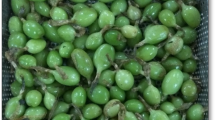Abstract
Chilies are an important agricultural product that is becoming a potential product in Indonesia. Chilies need to be dried in order to be durable. A new drying method was investigated in this study using a simple radiator as a heating source of the heating room. The amount of heat that can be transferred depends on the tested parameters. One parameter is the water temperature. Therefore, our aim was to determine the effect of inlet temperature and ventilation on the heat transfer and water content removal. The temperature employed at the entrance of the radiator varied from 60 °C to 80 °C, while the water mass flow rate used was kept at approximately 12 g/s. The initial heating room temperature was around 30 °C. Agricultural products tested were red chilies with a water content of 86 % - 90 %. The results show that variation of water temperature affects the heat transfer rate and the water content removal, while the prevailing ventilation supports the heat transfer rate but decreases the water removal.
Similar content being viewed by others
References
A. Fudholi, M. Y. Othman, M. H. Ruslan and K. Sopian, Drying of malaysian Capsicum annuum L. (Red Chili) dried by open and solar drying, International J. of Photoenergy (2013) 1–9.
S. Janjai, P. Intawee, J. Kaewkiew, C. Sritus and V. Khamvongsa, A large-scale solar green house dryer using polycarbonate cover: modeling and testing in a tropical environment of Lao People's Domestic Republic, Renewable Energy, 36 (2011) 1053–1062.
Statistical Yearbook of Indonesia (2015).
V. Palled, S. R. Desai and M. Anantachar, Performance evaluation of solar tunnel dryer for chilly drying, Karnataka J. of Agricultural Science, 25 (4) (2012) 472–474.
D. Herawan, Uji percontohan (pilot testing) pengering cabe merah (capsicum annuum L) tipe konveksi bebas untuk pengusaha tingkat pedesaan, Skripsi, FTP, IPB, Bogor (1992).
S. M. Tasirin, S. K. Kamarudin, K. Jaafar and K. F. Lee, The drying kinetics of bird's chilies in a fluidized bed dryer, J. of Food Engineering, 79 (2007) 695–705.
M. Mirmanto, E. D. Sulistyowati and I. D. K. Okariawan, Effect of radiator position and mass flux on dryer room heat transfer rate, Results in Physics, 6 (2016) 139–144.
T. Calisir, S. Baskaya, H. O. Yazar and S. Yucedag, Experimental investigation of panel radiator heat output enhancement for efficiency thermal use under actual operating conditions, EPJ Web of Conference, 92 02010 (2015).
J. A. Myhren and S. Holmberg, Performance evaluation of ventilation radiator, Thermal Science Technology, 32 (2012) 63–71.
R. Vitarini, Mempelajari karakteristik pengeringan cabe merah (Capsicum annuum L) dengan menggunakan microwave, Skripsi, Teknik Pertanian, IPB, Bogor (2003).
D. Fatimah and L. M. Estiaty, Preservasi kesegaran cabai merah (hot beauty & keriting) dengan zeolit alam teraktivasi, Rnal Zeolit Indonesia, 2 (1) (2003) 24–30.
N. Hartuti and R. M. Sinaga, Pengeringan cabe, Monograf no. 8, Balai Penelitian Tanaman Sayuran, Bandung (1997).
J. P. Holman, Heat transfer, 8th ed., McGraw-Hill, USA (1997).
F. P. Incropera, D. P. Dewitt, T. L. Bergman and A. S. Lavine, Fundamental of Heat and Mass Transfer, 6th ed., Wiley, USA (2006).
J. Owusu, H. Ma, Z. Wang and A. Amissah, Effect of drying method on physicochemical properties of pretreated tomato (lycopersicon esculentum mill) slices, Croatian Journal of Food Technology, Biotechnology and Nutrition, 7 (1-2) (2012) 106–111.
N. M. Chinenye, Effect of drying temperature and drying air velocity on the drying rate and drying constant of cocoa bean, The CIGR Ejournal, 11 (2009) Manuscript 1091.
M. Embaye, R. K. Al-dadah and S. Mahmoud, Effect of flow pulsation on energy consumption of a radiator in a centrally heated building, International J. of Low-Carbon Technologies (2014) 1–11.
W. Qu and I. Mudawar, Experimental and numerical study of pressure drop and heat transfer in a single-phase microchannel heat sink, International J. of Heat and Mass Transfer, 45 (2002) 2549–2565.
Author information
Authors and Affiliations
Corresponding author
Additional information
Recommended by Associate Editor Jae Dong Chung
Mirmanto received the Bachelor Degree in Mechanical Engineering from Gadjah Mada University, Indonesia in 1996 and Master Degree in Mechanical Engineering from Gadjah Mada University, Indonesia in 2000, respectively. His Ph.D. was achieved at Mechanical Engineering Department, School of Engineering and Design, Brunel University, United Kingdom in 2013. He is a Lecturer at Mechanical Engineering Department of Mataram University, Indonesia. His research interests are in the area of fluid and heat transfer, flow in microchannels, renewable energy and energy recovery.
Syahrul received the Bachelor Degree in Mechanical Engineering from Hasanuddin University, Indonesia in 1993, Master Degree in Mechanical Engineering from Dalhousie University Canada in 2000 and Doctor of Philosophy in Engineering from Okayama University Japan in 2008 at Mechanical Engineering Department. He is a Lecturer at Mechanical Engineering Department of Mataram University, Indonesia. His research interests are in the area of thermal fluid and heat transfer, drying, two phase flow, and renewable energy.
Emmy Dyah Sulistyowati received the Bachelor Degree in Statistical Mathematic from ITS, Indonesia in 1985 and Master Degree in Engineering and Management Indutri / Techno- Economics from ITB, Indonesia in 2002, respectively. Her research interests are in the area of materials, statistics, mathematics, and composite.
Idk Okariawan received the Bachelor Degree in Mechanical Engineering, Udayana University, Indonesia and Master Degree in Mechanical Engineering, ITS, Indonesia, respectively. His research interests are in the area of materials and composite.
Rights and permissions
About this article
Cite this article
Mirmanto, Syahrul, Sulistyowati, E.D. et al. Effect of inlet temperature and ventilation on heat transfer rate and water content removal of red chilies. J Mech Sci Technol 31, 1531–1537 (2017). https://doi.org/10.1007/s12206-017-0252-8
Received:
Revised:
Accepted:
Published:
Issue Date:
DOI: https://doi.org/10.1007/s12206-017-0252-8




